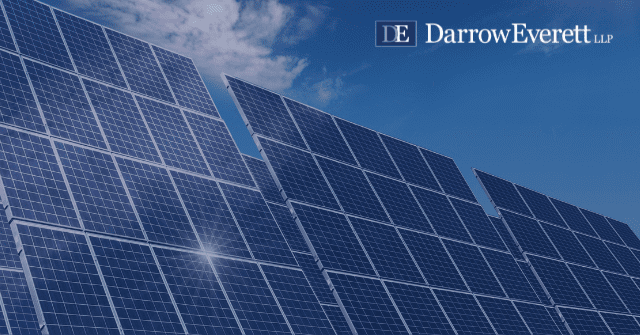
With the proliferation of renewable energy and sustainable technologies, individuals of every income range have tried to find ways to benefit from the technological advances. Those who have the resources and interest may purchase an electric vehicle; those who want to minimize their carbon footprint may use more efficient heating and lighting; but those who want to lower their utility bill are stuck with two options — install your own solar system or purchase energy from a solar power project. Community solar programs enable the latter option for a much broader range of individuals.
What Is Community Solar?
Community solar programs are state-run programs that create economic incentives for solar power projects to produce energy available for purchase by individual residences in a given area, usually at a discounted price. Generally, a community solar program works through a solar project owner agreeing to sell the electricity generated to the local utility in exchange for utility bill credits that are later sold to the consumers.
Community solar programs are intended to create affordable clean energy for consumers that cannot afford to install solar panels, or who don’t have the ability to install solar panels, such as individuals living in apartments. For solar project owners, the programs provide access to additional revenue by serving a market that would otherwise be unavailable. Additionally, recent changes to federal tax law through the Inflation Reduction Act created additional economic incentives that can be earned in connection with a community solar program.
How Do Community Solar Programs Differ Between States?
Community solar programs vary state to state. There is legislation which encourages or mandates community solar in 22 states, while 17 states and the District of Columbia have low-income community solar legislation.[1] Depending on the state in which the project is located, there are different requirements for project eligibility, different requirements for the amount of residential or low-income subscribers, and even different mandated discounts that must be offered to subscribers.
For example, the Illinois Shines Program currently operates the Adjustable Block Program, which offers Renewable Energy Credits (“RECs”) to solar power project owners. Under the Illinois Shines Program, one REC is issued to a developer per one megawatt-hour of electricity produced by the solar power project. The RECs are issued to vendors approved by an agent of the Illinois Power Agency over the contract period (typically the first 15 or 20 years of operations).[2] In order for a project to qualify as a community solar project under this program, at least 50% of the total project capacity (based on usage of the project’s nameplate capacity) must be sold to “small subscribers,” meaning each of those subscribers are purchasing energy generated by no more than 25 kW AC of the total solar project size.[3]
Under the NY-Sun program, however, community solar projects must have no less than 60% of the total project capacity allocated to subscribers that purchase less than 25 kW AC of the total solar project size. New York also has an Inclusive Community Solar Adder (ICSA) for community solar projects that serve low-to-moderate income subscribers; projects must dedicate at least 40% of the project capacity to “eligible subscribers” under the program (including residential subscribers and affordable housing/nonresidential subscribers), but at least 50% of the project’s ICSA capacity must be dedicated to residential subscribers (including homeowners, renters and residents of multifamily buildings).[4] In exchange for meeting the program requirements, a project receives an increased incentive (on a $/watt basis).
How Are State Solar Programs Changing?
State solar program regimes, and the community solar programs within them, are constantly changing as new developments are made and past practices are refined. For example, as described above, a project must sell at least 50% of the total project capacity to small subscribers for the project to qualify as a community solar project in the Illinois Shines Program. However, under the 2019 REC Delivery Contract, which dictates the adders provided to community solar projects, projects were not required to meet a specific percentage of small subscribers; instead, different adders were available based on the percentage of small subscribers.[5] Community solar projects that were approved by the Illinois Commerce Commission prior to the enactment of the Climate and Equitable Jobs Act (Public Act 102-0662, Illinois General Assembly, 2021) have been “grandfathered” into a percentage-based variable adder system. However, community solar projects that were approved after such enactment have the small subscriber adder incorporated into the base price for community solar projects and no longer have a distinct small subscriber adder; the adder incorporated into the base price is equal to the adder for 50%-75% under the percentage-based variable adder system.
In terms of changes in existing solar programs on the horizon, the NY-Sun program is undergoing a mid-program review which likely will result in changes to the program this summer. One potential change could involve a recommendation made by the New York State Energy Research and Development Authority to the New York Public Service Commission to expand the state’s current 10-gigawatt goal using existing NY-Sun program funding.[6]
Many states, which already have non-regulated community solar programs, have bills being considered that would create a regulatory regime to apply to future projects and expand their availability within the state.[7] For example, the Ohio legislature is currently considering House Bill 197 which would establish community solar pilot and solar development programs in the state.[8] The bill has support from the public and is currently under review by the public utilities house committee, where legislators recently released a substitute bill that will address concerns and which should allow the bill to move forward.[9]
Conclusion
Community solar programs are a great opportunity for developers and consumers alike, offering both sides financial benefit through the development of more available energy from solar power projects. For developers, the additional legwork to qualify a project for community solar incentives may require considerable time and cost; however, as with all solar projects, the marginal increase in incentives can make or break some projects. With the state-specific incentives changing over time, prudent developers and asset owners need to monitor changes to community solar programs to determine whether they can, or should, participate.
——————————————————————–
This DarrowEverett Insight should not be construed as legal advice or a legal opinion on any specific facts or circumstances. This Insight is not intended to create, and receipt of it does not constitute, a lawyer-client relationship. The contents are intended for general informational purposes only, and you are urged to consult your attorney concerning any particular situation and any specific legal question you may have. We are working diligently to remain well informed and up to date on information and advisements as they become available. As such, please reach out to us if you need help addressing any of the issues discussed in this Insight, or any other issues or concerns you may have relating to your business. We are ready to help guide you through these challenging times.
Unless expressly provided, this Insight does not constitute written tax advice as described in 31 C.F.R. §10, et seq. and is not intended or written by us to be used and/or relied on as written tax advice for any purpose including, without limitation, the marketing of any transaction addressed herein. Any U.S. federal tax advice rendered by DarrowEverett LLP shall be conspicuously labeled as such, shall include a discussion of all relevant facts and circumstances, as well as of any representations, statements, findings, or agreements (including projections, financial forecasts, or appraisals) upon which we rely, applicable to transactions discussed therein in compliance with 31 C.F.R. §10.37, shall relate the applicable law and authorities to the facts, and shall set forth any applicable limits on the use of such advice.
[1] https://www.energy.gov/eere/solar/community-solar-basics
[2] https://illinoisshines.com/solar-and-basics/#solar-incentives
https://illinoisshines.com/wp-content/uploads/2023/06/Current-Program-Guidebook_May_31_2023.pdf, page 7
[3] https://illinoisshines.com/wp-content/uploads/2023/06/Current-Program-Guidebook_May_31_2023.pdf, page 87
[4] https://www.nyserda.ny.gov/All-Programs/NY-Sun/Contractors/Dashboards-and-incentives/Inclusive-Community-Solar-Adder
[5] https://illinoisshines.com/wp-content/uploads/2023/06/Current-Program-Guidebook_May_31_2023.pdf, pg. 86
[6] https://www.jdsupra.com/legalnews/nyserda-reports-on-the-impacts-of-the-3527049/
[7] https://www.energy.gov/eere/solar/community-solar-basics
[8] https://www.legislature.ohio.gov/legislation/135/hb197
[9] https://solarbuildermag.com/projects/ohio-community-solar-bill-to-move-forward-with-substitute-bill-and-hearing/


